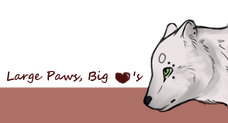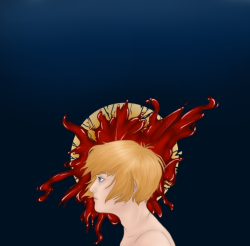
Most humans haven't seen these shy, rare, and rather timid animals
called the Rifska. Most haven't even heard the name of these
legendary creatures of the deep, not to mention can describe
what they look like. With long, powerful fish-like tails, Rifska
can swim up to 30 miles per hour, though they usually cruse
along at an easy five. Resembling dogs, many have indeed
mistaken them to be someone's pooch, playing far out at sea,
or even those with worse eyesight, a dolphin. They do leap out
of the waves like the flippered mammals, but do not share many
other traits.

They have fur, yes, and huge fins on both their backs and tail.
Webbed paws and an areodynamic head, Rifska slice through the waves
with ease, often overtaking their enemies, sharks. Males have poison in
their back fin, but only use it when attacked. Poison doesn't release
when a spine it touched, so even if another Rifska bumped into them,
they wouldn't die. But, even if they did, it wouldn't matter, as Rifska are
immune to most poisons because their skin is thick and their bodies absorb
the chemicals, then store them to be released with waste. All Rifska have
a series of "dots" on their back, lining either side of their back fin.
These are called "search lights" because they glow with an eerie way
when the Rifska goes into deep waters where there is no light.
Both genders of Rifska can breathe above water, and walk on land, for a
limited time, at most three days. They love shiney things, and males tend
to impress females during mating season with how sparkly their tail is
and how wonderful their gift it. A "gift" can be anything from an oyster's pearl,
the oyster itself, a beautiful fish, or even the beginning of a home.
Rifska couples mate for life, and create a home together, where they will live until one dies, or the pod moves on or is drivin out. {A group of seven or more Rifskas is called a pod. More than thirty is called a gathering, and less than seven a group.} A home is made up of coral reefs, carved to make spacey caverns, lined with many, many gifts and other such little treasures that the pair collects. Rifska never steal from others of their own kind, and keep fish or turtles as pets. A fish is the "cat" of their life, and a sea turtle a "dog," since Rifska can grow up to be ten feet long these sizes make sense to them. A leatherback turtle is their "horse" and sea horses simply like our fish. Somewhat pets, somewhat decorations.
The way that ranks work in a pod is simular to that of a wolf pack, though there is one lead female, her mate, a few hunters, warriors, and Riffie-sitters {a Riffie is a baby Rifska from a newborn to the age of nine months.} and of course, the Riffies. Everyone except for the lead pair are on the same level, and treat eachother with the same amount of respect.
Rifskas can mate once they reach the age of one, but usually don't until they're two. Breeding season comes around every autumn, and lasts until winter. Many pods gather in one area to socialize and widen the breeding pools, though this isn't done without feeling. It's also done to let the younger members move around a little, make their own decisions. Riffies are kept back in the pod's area of living, where all the homes are. Going to the Gathering is a rite of passage, and the oldest in the pod look after them. A group of up to four Riffies can be born at a time to a mother, so she can have many, many Riffies during her life time.Fun Facts
` Rifskas live up to be 200 years old on average
` Males tend to be larger than females, but females can still whup their butts
` They are very sweet and love companionship
` Numbers are dwindling, and there are now less than 500 left in the wild
` It takes 11 months before a baby Rifska is born
` They have boyfriends and girlfriends at young ages
` Rifskas can, and often do, get sunburned

Babies, or Riffies, as they're more commonly called, are fun-loving, sweet, bouncy bundles of joy. They love to play with anything and everything they can, whether or not it wants to play with them. They are born with very thick fur and absoloutly no spines. The scales on their tails are so small and fine that they don't even appear to be there at all. Most Riffies have dull markings that will develope as they mature, and some markings that will just fade away or change entirely. The markings around their eyes never change, which is said to be because their eyes don't grow either. Riffies have lots of fluffy fur to help protect them from predators that want to eat them. It also keeps them warmer. As the babies grow, their fur will thin out to make them faster swimmers. All of them have only three seach lights along their backs, since they never really go that deep, and their spines are yet too short for any more.
Teen Rifskas, Rivvs, are often singled out for their odd tail shape. When a baby Rifska is born, the tail isn't really divided into two sections yet, so this happens during the Rivv stage of their life. Their top fluke always developes faster than the bottom. Rivvs are a tad bit moody, but still love to play around. At this age, they form cliques of close friends and begin looking for "dates." This is good behavior to date, and their parents strongly encourage it, as it gives the teen a taste of what is a good future mate, and who will drive you out of your mind. Markings become a little stronger, the mane starts to develop, and fins are growing. Their fur is a lot thinner than it had been at birth, but, it doesn't make them any colder. More search lights form, and at this point, most Rivvs have around 11 of them, five on either side, and one in the middle behind the back fin.
Finally, the adult stage! Adult Rifskas don't have any fancy nicknames, they are simply called Rifskas. Females tend to be smaller, but not all of them are. Markings are fully developed now, and it is very rare for a Rifska to have the exact same markings it had at birth, or a solid color. Their tails are fully formed, and allow them to swim up to thirty miles an hour at top speed. A lot of Rifskas have stripes on their body, and all of them have a lighter stripe running down the very top of their mane. Both males and females have manes, there is no visable difference between the two genders. Adults can converse to humans, and make sound above the water. Only they are allowed on land anyways, but before this "rule" was created, youngsters were killed because they were believed to be stupid beasts. Rifskas are still a mystery at this point though, and love to confuse humans with mind-boggling tricks.














